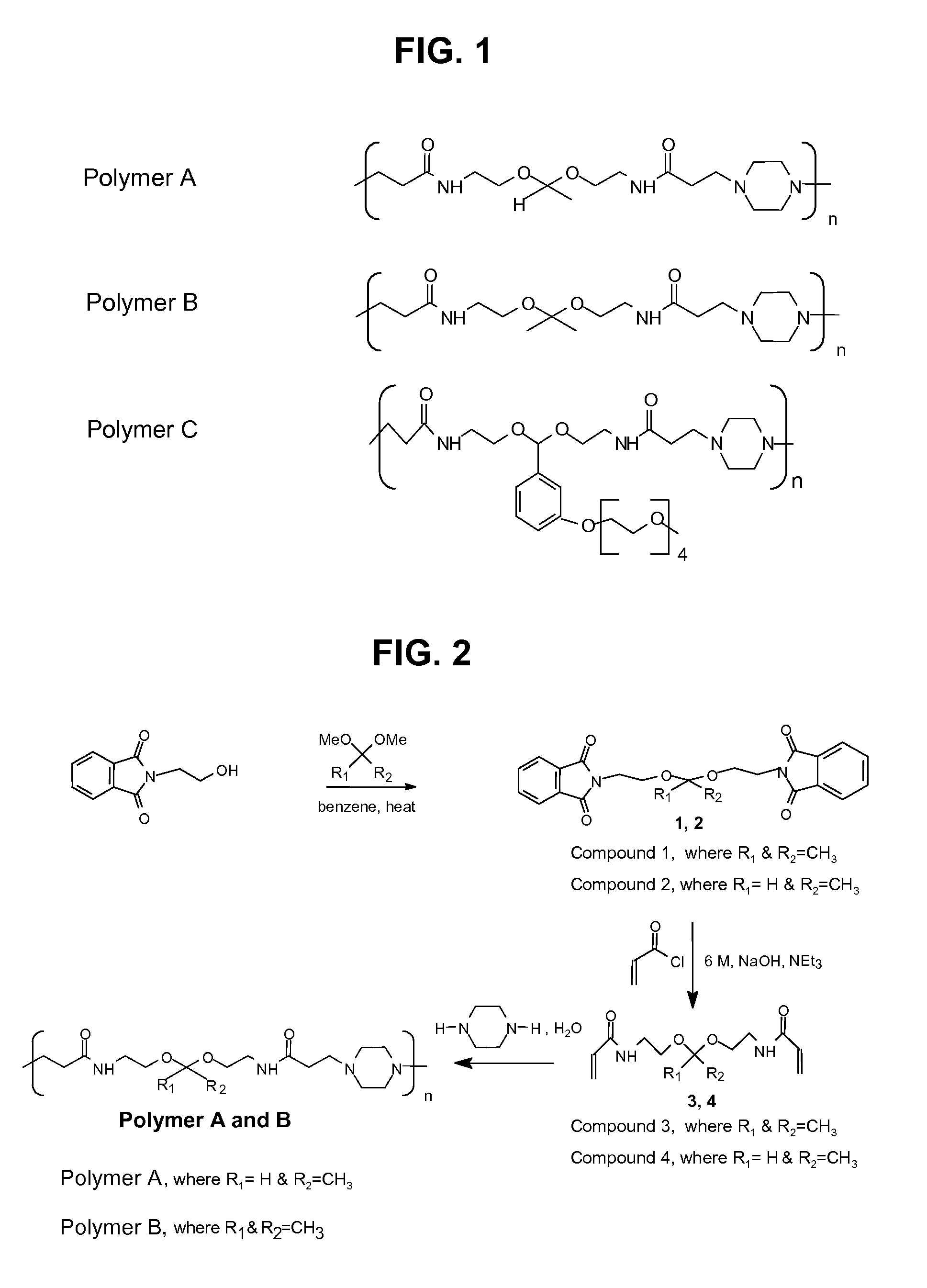Main chain acid-degradable polymers for the delivery of bioactive materials
a bioactive material and acid-degradable technology, applied in the direction of biocide, peptide/protein ingredients, microcapsules, etc., can solve the problems of long-term vacuolization, inability to meet the requirements of most available polymers, and none of the available materials combining all the desirable properties, etc., to achieve the effect of changing the hydrolysis rate of these polymers
- Summary
- Abstract
- Description
- Claims
- Application Information
AI Technical Summary
Benefits of technology
Problems solved by technology
Method used
Image
Examples
example 1
[0142]Synthesis and Characterization of Main-Chain Acid-Degradable Bisacrylamide Polymers A, B and C
[0143]This example highlights the synthesis of different acid degradable bisacrylamide monomers, which reacted with piperazine by Michael addition polymerization resulting in a series of pH sensitive polyamidoamines that will eventually become scaffolds for various drug delivery systems. These polymers have ketal linkage in its backbone, which degrades by acid catalyzed hydrolysis into low molecular weight compounds that can be completely excretable. The rate of hydrolysis of these polymers can be changed by varying the ketal linkage from slow degrading to fast degrading and thus providing a wide range of release kinetics for drug delivery.
[0144]A group of three poly (amidoamines) structures (FIG. 1) were selected and synthesized with different acid sensitive linkages. The overall synthetic schemes for the preparation of Polymer A, B and C is given in FIG. 2 and FIG. 3.
[0145]Design an...
example 2
[0175]Synthesis of Acid Degradable Diamine, Isocyanate and Activated Diol Monomers
[0176]The first step in preparing the pH sensitive polyurea and polyurethanes was the synthesis of several functional monomers. Polyureas are commonly prepared via condensation of diamine and diisocyanate monomers. Therefore, a similar AA, BB system based on a diamine that contained dimethyl ketal to install acid sensitivity was designed. According to the literature, the hydrolysis half-life of a similar dimethyl ketal at pH 7.4 was 6 hours, but was 1.5 minutes at pH 5 demonstrating its pH dependent degradation kinetics (See Kwon, Y. J.; Standley, S.; Goodwin, A. P.; Gillies, E.; Frechet, J. M. J., Mol Pharm 2005, 2, 83-91.).
[0177]The acid degradable diamine monomer was synthesized in 2 steps by a procedure adapted from the literature (FIG. 9). First, an acetal exchange was performed using 1,2-dimethoxypropane and N-(2-hydroxyethyl)-pthalimide to prepare compound 9. To ensure the equilibrium shifted to...
example 3
[0188]Synthesis of Acid-Degradable Polyurea and Polyurethane Polymers
[0189]Polyureas 17, 18 and 19 were formed by the interfacial step polymerization of degradable diamine 10 and monomers 11, 12, or 13. FIG. 11 shows the resulting polymers. The diamine was solubilized in water and then added to the diisocyanate or activated diamine monomer dissolved in dichloromethane. The resulting polymers precipitated from the reaction solution and the powder was isolated by filtration in high yields.
[0190]Preparation of Acid Degradable Polyureas 17, 18, 19. Compound 10 (0.102 g, 1 equiv., 0.63 mmol) was dissolved in CH2Cl2 (5 mL). To this solution aqueous buffer (5 mL, 30 mM phosphate, pH 8) and triethylamine (9 μL, 0.1 equiv., 0.06 mmol) were added and the mixture was stirred rapidly to form an emulsion. A solution of freshly distilled diisocyanate 11 or 12 (105 μL, 1 equiv., 0.65 mol) in CH2Cl2 (5 mL) was then added in one portion to the stirred emulsion, and stirring was continued at rt for 1...
PUM
| Property | Measurement | Unit |
|---|---|---|
| particle size | aaaaa | aaaaa |
| particle size | aaaaa | aaaaa |
| particle size | aaaaa | aaaaa |
Abstract
Description
Claims
Application Information
 Login to View More
Login to View More - R&D
- Intellectual Property
- Life Sciences
- Materials
- Tech Scout
- Unparalleled Data Quality
- Higher Quality Content
- 60% Fewer Hallucinations
Browse by: Latest US Patents, China's latest patents, Technical Efficacy Thesaurus, Application Domain, Technology Topic, Popular Technical Reports.
© 2025 PatSnap. All rights reserved.Legal|Privacy policy|Modern Slavery Act Transparency Statement|Sitemap|About US| Contact US: help@patsnap.com



